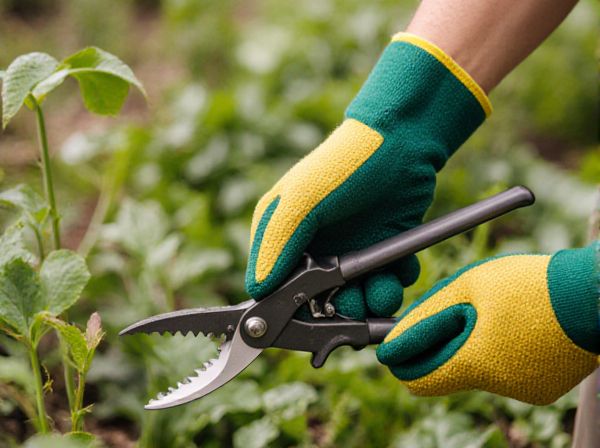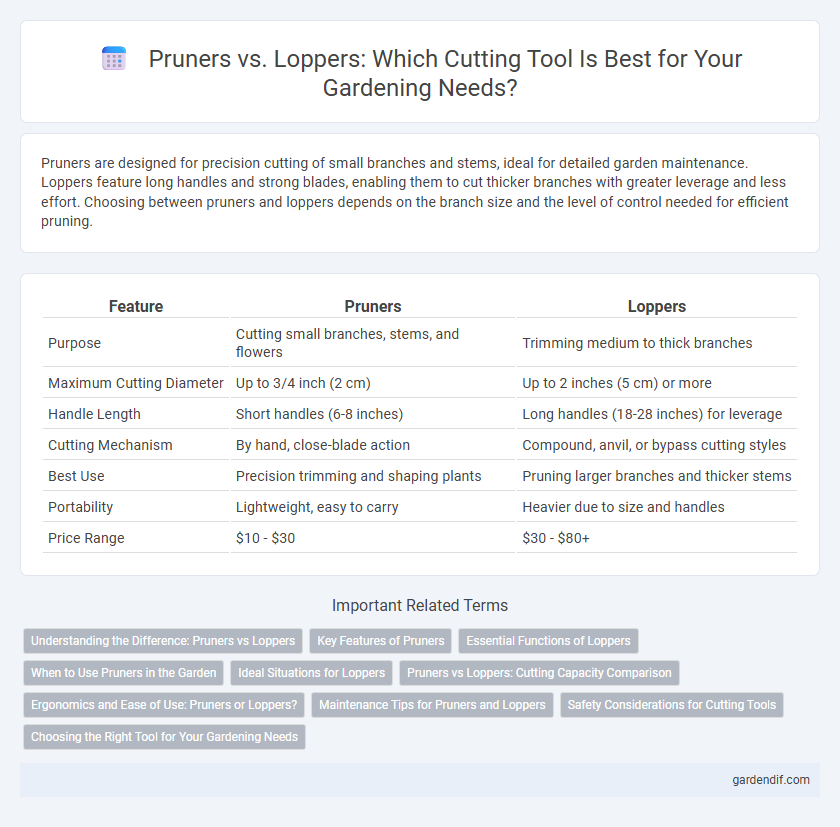
Pruners vs Loppers Illustration
Pruners are designed for precision cutting of small branches and stems, ideal for detailed garden maintenance. Loppers feature long handles and strong blades, enabling them to cut thicker branches with greater leverage and less effort. Choosing between pruners and loppers depends on the branch size and the level of control needed for efficient pruning.
Table of Comparison
| Feature | Pruners | Loppers |
|---|---|---|
| Purpose | Cutting small branches, stems, and flowers | Trimming medium to thick branches |
| Maximum Cutting Diameter | Up to 3/4 inch (2 cm) | Up to 2 inches (5 cm) or more |
| Handle Length | Short handles (6-8 inches) | Long handles (18-28 inches) for leverage |
| Cutting Mechanism | By hand, close-blade action | Compound, anvil, or bypass cutting styles |
| Best Use | Precision trimming and shaping plants | Pruning larger branches and thicker stems |
| Portability | Lightweight, easy to carry | Heavier due to size and handles |
| Price Range | $10 - $30 | $30 - $80+ |
Understanding the Difference: Pruners vs Loppers
Pruners, also known as hand pruners or secateurs, are designed for cutting small branches and stems up to 3/4 inch thick, offering precision for detailed gardening tasks. Loppers feature long handles and a cutting capacity of up to 2 inches, providing greater leverage for trimming thicker branches and harder-to-reach areas. Selecting between pruners and loppers depends on branch thickness and the need for reach or torque in pruning tasks.
Key Features of Pruners
Pruners, also known as hand pruners or secateurs, feature sharp, curved blades designed for precision cutting of small branches and stems up to 3/4 inch thick. They typically include ergonomic handles for comfortable grip and often incorporate a spring mechanism to reduce hand fatigue during repetitive use. Lightweight and compact, pruners excel in detailed pruning tasks, making them ideal for shaping plants and deadheading flowers.
Essential Functions of Loppers
Loppers are designed for cutting thicker branches, typically up to 2 inches in diameter, making them essential for heavy pruning tasks that require more leverage and force than pruners provide. Their long handles enable greater cutting power and reach, allowing gardeners to trim hard-to-reach limbs and maintain tree health effectively. The essential function of loppers is to facilitate precise, clean cuts on larger woody stems, promoting plant growth and preventing damage from tearing or crushing.
When to Use Pruners in the Garden
Pruners are ideal for precise cuts on small branches, stems, and flowers up to 3/4 inch thick, ensuring clean cuts that promote healthy plant growth. Use pruners for shaping shrubs, deadheading flowers, and removing delicate growth without damaging surrounding foliage. Their compact size allows for easy maneuvering in tight garden spaces, making them essential for detailed trimming tasks.
Ideal Situations for Loppers
Loppers are ideal for cutting thick branches between 1 to 2 inches in diameter, making them perfect for pruning trees and shrubs that require more leverage than pruners can provide. Their long handles deliver increased cutting force, allowing users to reach higher branches or dense foliage without needing a ladder. They excel in trimming medium-sized limbs and shaping garden plants where precision and power are essential.
Pruners vs Loppers: Cutting Capacity Comparison
Pruners typically offer a cutting capacity of up to 3/4 inch in diameter, making them ideal for precision trimming and small branches. Loppers, on the other hand, handle thicker branches ranging from 1 to 2 inches in diameter, providing greater leverage and power for heavier pruning tasks. Choosing between pruners and loppers depends on the branch size, with pruners suited for finer cuts and loppers designed for more substantial wood.
Ergonomics and Ease of Use: Pruners or Loppers?
Pruners offer superior ergonomics for detailed trimming tasks due to their lightweight design and comfortable grip, reducing hand fatigue during prolonged use. Loppers, with longer handles and greater leverage, require more effort but enable cutting thicker branches with less wrist strain. Choosing between pruners and loppers depends on the specific task, balancing ease of use with the physical demands of pruning or cutting.
Maintenance Tips for Pruners and Loppers
Regularly cleaning pruners and loppers with warm soapy water prevents sap buildup and rust, enhancing blade longevity and cutting efficiency. Sharpen blades using a sharpening stone or file to maintain precise cuts and reduce plant damage. Lubricate pivot points with lightweight oil to ensure smooth operation and prevent corrosion, extending the tool's lifespan.
Safety Considerations for Cutting Tools
Pruners and loppers require proper safety measures to prevent injuries during use, including wearing protective gloves and safety glasses to guard against sharp blades and flying debris. Regular maintenance, such as sharpening blades and tightening loose parts, ensures clean cuts and reduces the risk of accidents caused by tool malfunction. Using tools appropriate to the branch size--pruners for smaller branches up to 3/4 inch and loppers for thicker branches up to 2 inches--minimizes strain and enhances control for safer cutting operations.
Choosing the Right Tool for Your Gardening Needs
Pruners are ideal for precision cutting on smaller branches up to 3/4 inch in diameter, making them perfect for detailed pruning tasks, while loppers handle thicker branches up to 2 inches, providing leverage and power for heavier pruning. Selecting the correct tool depends on the branch thickness and accessibility; pruners offer control for delicate shaping, whereas loppers increase reach and cutting force for larger growth. Understanding these differences ensures efficient garden maintenance and healthier plant growth.
Pruners vs Loppers Infographic

 gardendif.com
gardendif.com